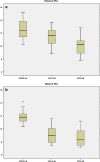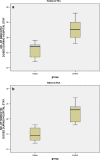Platelet-rich plasma prevents blood loss and pain and enhances early functional outcome after total knee arthroplasty: a prospective randomised controlled study
- PMID: 24114251
- PMCID: PMC3923931
- DOI: 10.1007/s00264-013-2136-6
Platelet-rich plasma prevents blood loss and pain and enhances early functional outcome after total knee arthroplasty: a prospective randomised controlled study
Abstract
Purpose: The purpose of this study was to determine whether platelet-rich plasma (PRP) might prevent blood loss and postoperative pain and expedite wound healing following total knee arthroplasty (TKA).
Methods: Forty consecutive patients with knee arthritis who were matched for age, sex and body mass index (BMI) were randomly allocated to either receive or not receive PRP application over the wound, including capsule, medial and lateral recesses, during TKA. Postoperative haemoglobin, blood loss, blood transfusion, visual analogue scale (VAS) score, wound score, Knee Society Score (KSS) and Western Ontario and McMaster Osteoarthritis Index (WOMAC) score were recorded and evaluated.
Results: The platelet-rich plasma and control groups comprised 17 and 23 patients, respectively. The PRP group recorded significantly less reduction in haemoglobin and need for blood transfusion (p = 0.00 and p = 0.001, respectively), experienced less pain (p = 0.00) and required fewer narcotics than the control (p = 0.00). There was significant difference in range of motion (ROM) at three months (p = 0.01), no significant difference in wound scores (p = 0.311) and significant difference in KSS and WOMAC scores at 12 weeks (p = 0.00, 0.00). However no significant difference was found at six months.
Conclusions: PRP has significant effect in preventing blood loss, postoperative pain and need for narcotics after TKA and has a positive effect on short-term clinical outcome.
Figures





References
-
- Jones CA, Voaklander DC, Suarez-Alma ME. Determinants of function after total knee arthroplasty. Phys Ther. 2003;83:696–706. - PubMed
-
- Bierbaum BE, Callaghan JJ, Galante JO, Rubash HE, Tooms RE, Welch RB. An analysis of blood management in patients having a total hip or knee arthroplasty. J Bone Joint Surg Am. 1999;81:2–10. - PubMed
-
- Ishida K, Tsumura N, Kitagawa A, Hamamura S, Fukuda K, Dogaki Y, Kubo S, Matsumoto T, Matsushita T, Chin T, Iguchi T, Kurosaka M, Kuroda R. Intra-articular injection of tranexamic acid reduces not only blood loss but also knee joint swelling after total knee arthroplasty. Int Orthop. 2011;35(11):1639–1645. doi: 10.1007/s00264-010-1205-3. - DOI - PMC - PubMed
Publication types
MeSH terms
Substances
LinkOut - more resources
Full Text Sources
Other Literature Sources
Medical
Research Materials

